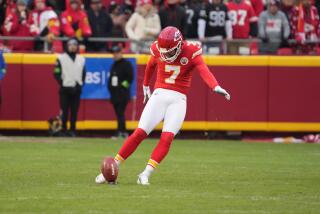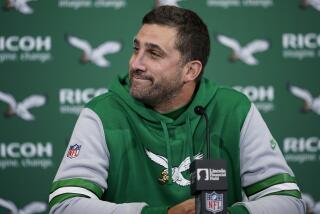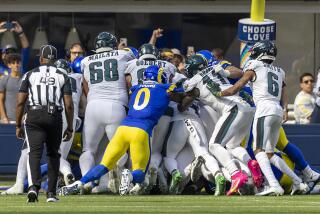Seahawks Won’t Bet Against the Spread
KIRKLAND, Wash. — A year ago, Jeff Chadwick and James Jones were elder statesmen in a Detroit Lions offense about to undergo a change.
Mouse Davis spent the spring implementing the Run-and-Shoot into a Detroit offense that had been known as the Duck-and-Sack. At first, Chadwick and Jones were excited. Chadwick was a 6-foot-3 receiver with speed. Jones carried the ball and the franchise’s offense on his broad shoulders through the Lions’ worst years.
“I was excited about the Run-and-Shoot,” Jones said. “I loved it. You know you’re the back and you know you’re going to get the running room.”
Little did they know that with the Run-and-Shoot came their own walking papers. The new offense cleaned out Chadwick and three other returning receivers, a starting tight end, two of the top three quarterbacks and all the running backs, including Jones, who was traded to the Seattle Seahawks for cornerback Terry Taylor.
And just when Chadwick and Jones thought they found peace and contentment in the Ground Chuck offense, Coach Chuck Knox switches to the Run-and-Shoot.
“They are only doing a portion of it,” Chadwick said. “It’s just a little package that we’re putting in. It is one of the things that helps to get the ball to different people.”
Judging from the practice Thursday, Knox’s so-called Spread offense showed more run than shoot. Four receivers spread the field, but quarterbacks spent half the time handing off to a lone setback.
The ‘90s might have spurred the development of Air Knox, but there’s still a lot of Ground Chuck bringing things down to earth.
“We had some pass plays in there,” quarterback Dave Krieg said. “There was only a couple of running plays and a couple of pass plays. I like the concept. It spread things out. You’ve got to utilize the things we’re best at and that is when we are in four wide receivers. That’s the thing we’ve been doing the best.”
In many ways, the Seahawks’ Spread offense is an expansion of their four wide receiver attack, which had been used mostly on third downs and ranks among the most productive units in the NFL in recent years. The Spread will be tried on some first- and second-down plays. The only way observers could tell the difference on third downs is whether Krieg plays directly behind center (in which case it’s the Spread) or if he’s in shotgun formation (the old four wide receiver set).
“We will run more out of the Spread than we do in the four wide receiver alignment,” John Becker, the offensive coordinator said.
Becker installed some of the fundamentals of the new scheme during the minicamp this week. Players’ reaction unanimously was positive.
“It’s a good changeup so that we won’t be predictable,” Pro Bowl wide receiver Brian Blades said. “It’s a real good outlet for receivers. No matter what coverages they get, someone should get open.”
As starters, Blades, Chadwick and Louis Clark are being used as the “wide” outs. Tommie Kane and Paul Skansi are the inside “slot.”
What comforted Chadwick the most was that the version used by Knox and Becker makes him an asset instead of a decoy as in the Run-and-Shoot system. In the pure Run-and-Shoot, split ends only make the job easier for the slot receivers.
“The outside guy in that Run-and-Shoot doesn’t get the ball that much,” Chadwick said. “They just clean out for the inside guys. You are doing the running but not getting the gratification that you want. In other words, you are not getting the ball thrown to you.”
Chadwick had plenty of chances Thursday. He broke his routes short and made receptions. He cut them to the sidelines for catches. Once, a cornerback muttered his frustrations after a Chadwick reception.
“This offense should keep defenses off balance,” Skansi said. “Defenses can’t tell if you are going to run or pass.”
“We’re not going to do what Detroit does and use it as 100 percent of your offense,” Becker said. “We are not taking every idea and are not becoming a true Run-and-Shoot team.”
Expect screen passes to the lone setback. Expect more running plays than normal. Working from a pure Run-and-Shoot, rookie Barry Sanders of Detroit led the National Conference in rushing with 1,470 yards.
A back as talented as John L. Williams could dream of gaining 1,000 yards receiving and rushing if he stays healthy. Standing behind him as a prime candidate for the one-back slot is Jones, who taught Williams how to be a fullback when they were teammates at the University of Florida.
“This will mix it up and make our offense more explosive,” Jones said. “In Detroit, in four years, we had three different head coaches. When you keep changing head coaches, you’re going to start cleaning out the old guys, and if you’re going to lose, you’re going to want to lose with young guys. Their offense require little guys who can catch the ball. They didn’t want to have a Jeff Chadwick, who is too tall. They were able to get something for me.”
Knox’s Spread doesn’t want midget, so Chadwick has a place. So do 230-pound running backs such as Williams or Jones.
And just remember, Knox and Becker keep insisting that the Run-and-Shoot can be used for the run.
More to Read
Go beyond the scoreboard
Get the latest on L.A.'s teams in the daily Sports Report newsletter.
You may occasionally receive promotional content from the Los Angeles Times.










